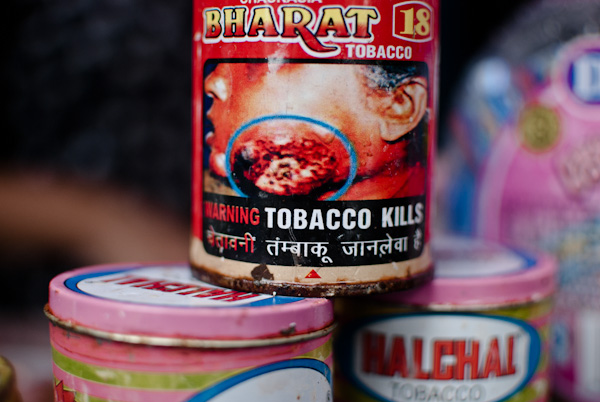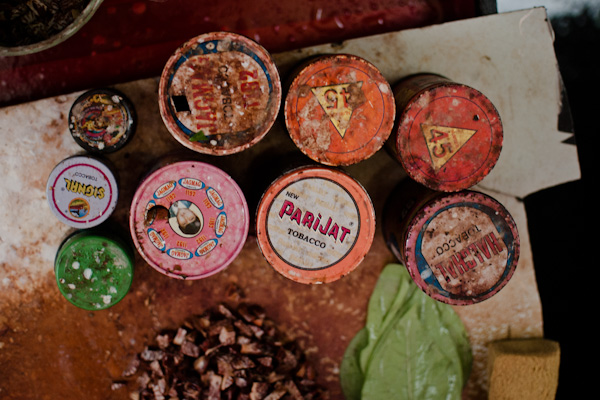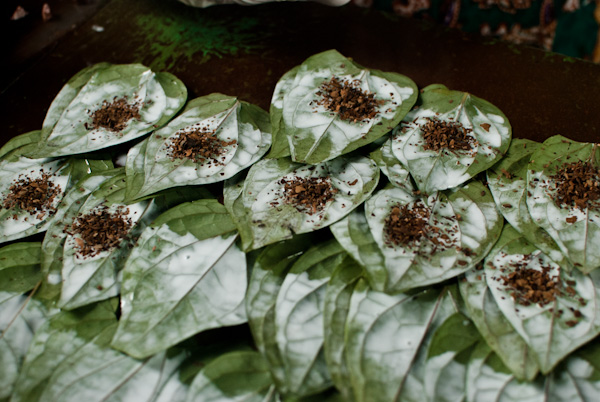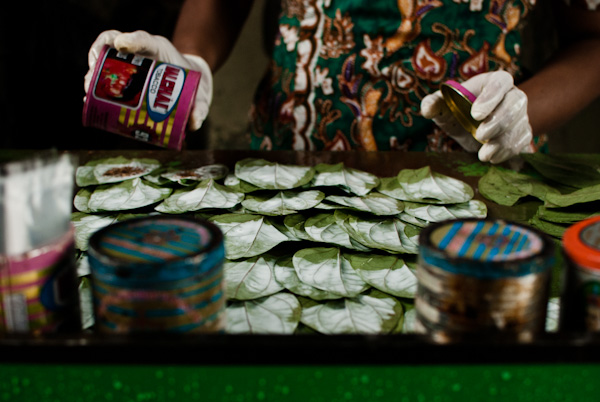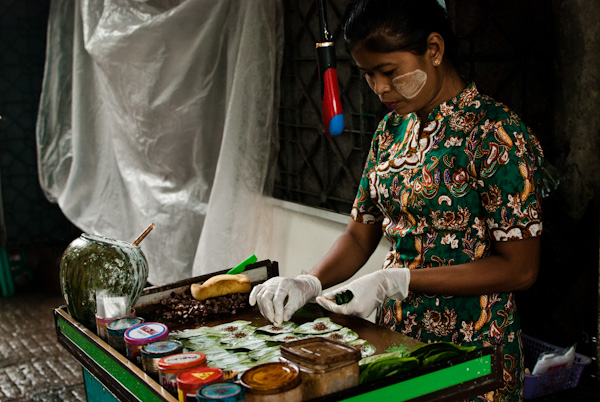The world’s fourth most common psychoactive habit delivers a potent buzz and lots of red saliva.
YANGON — When Myo Min Tun smiles he shows red-stained teeth, the mark of the long-time betel user. “If you chew three continuously, it’s equal to smoking a pack of cigarettes,” the 36-year-old says, picking up his daily fix of betel quids — small parcels of areca nuts and tobacco, wrapped in betel leaves coated with slaked lime.
Tun says he started chewing betel as a teenager, and now goes through about 40 parcels per day, which keep him going through long days at the tea shop where he works in downtown Yangon. “When I eat a lot, my heart beats faster,” he says. “I can’t stop.”
Betel nut — or “kun,” as it is known locally — is a popular pick-me-up in Myanmar, a mild stimulant which gives users a burst of energy similar to that from a cup of tea or coffee. In the streets of this crumbling former capital, betel sellers sit on nearly every corner. The pavement is covered in splotches of red betel juice spat out by chewers.
Use of betel nut (so-called for its combination of betel leaves and areca nuts) is common throughout Asia, but few countries chew their way through as much as Myanmar, which accounts for more than half of Southeast Asia’s betel consumption, according to the World Health Organization (WHO). Recent figures show that approximately one in four people in the cities chomp down regularly on betel quids, whose combination of areca nut, betel leaf and tobacco produce a potent buzz and a lot of excess red saliva.
But Myanmar’s kun aficionados could be getting a lot more than a stained smile. Extensive research has shown that chewing betel quids has dire health consequences, including cancer. Professor Ying-chin Ko, a researcher at China Medical University in Taiwan, who has studied the health effects of betel quids since the 1990s, says betel chewing is closely correlated with various forms of oral cancer, whether or not tobacco is included in the packages. The habit has also been linked to obesity, metabolic syndrome, and heart disease. “Betel nut is an addictive substance, and it’s not easy to give up,” Ko says.
Betel has deep cultural and historical roots in South and Southeast Asia. It is mentioned in ancient Sanskrit texts, and has turned up on teeth excavated from Bronze Age sites in modern-day Vietnam. Throughout the region it plays a role in marriage ceremonies and is prized as a folk cure for everything from acne and indigestion to bad breath. In some places it acts as a social lubricant and a prelude to courtship. In Cambodia, a traditional saying instructs, “a quid of betel nut is the prelude to all conversation.”
Today there are about 600 million betel users worldwide — most of them in Asia. The WHO ranks it as the fourth most commonly used psychoactive substance after alcohol, tobacco, and caffeinated drinks like coffee and tea. “You get dizzy the first time, but you get used to it. It’s kind of like smoking,” says betel seller Maung Oo, 50, sitting behind a table covered with stacked betel leaves and rusty tobacco tins from India, some bearing grim health warnings.
As his customers line up for their morning quid, Maung Oo works quickly, arranging the betel leaves in rows and dabbing each with sour-smelling lime solution. He adds chunks of areca nut and a sprinkle of dried tobacco to each. Sweeteners are sometimes added to taste, as are spices like aniseed or cardamom. He then wraps the quids in small plastic bags sealed with toothpicks. Who are his best customers? “Burmese, Indians, Muslims — all kinds of people,” he says, flashing his own red-stained smile. “You can see from their mouths.”
Today there are about 600 million betel users worldwide — most of them in Asia. The WHO ranks it as the fourth most commonly used psychoactive substance after alcohol, tobacco, and caffeinated drinks like coffee and tea.
In 2006 Myanmar passed a tobacco control law banning smoking and betel-chewing in public places such as schools and hospitals. But health experts say the sale of kun remains, and the ban goes virtually unenforced. “It’s very cheap. For 300 kyats [about US$0.35] you can get four packages,” says Dr. Tint Tint Kyi, a senior consultant physician at Insein General Hospital in Yangon. Treating betel addicts, she has seen first-hand how hard it is to kick the habit. Even when users are aware of the dangers, many continue to chew. “Addiction is very dangerous. Highly addicted people don’t want to listen at all,” she says. “It’s a social disease.”
Some Asian countries have instituted more stringent controls on betel nut. Last year the government of Papua New Guinea banned the practice of chewing it in the capital Port Moresby, but this was more to eradicate the red stains on the sidewalks than to promote public health.
Another problem is that many anti-tobacco laws focus on smoking rather than smokeless forms of tobacco consumption like betel quids. “This habit really undermines our efforts,” says Dr. Nyo Nyo Kyaing, a regional advisor for the World Health Organization’s Tobacco-Free Initiative. “People are still not fully aware of the hazards, enforcement is weak and the taxes are low so it is easily affordable.” In addition to educating people about the health effects of kun, she says the laws need to be updated to include betel quid in anti-smoking campaigns and regulations.
U Soe Thu, 23, is aware of the health problems, but chews kun anyway. He says a quid every few hours helps him stay alert during long shifts at a hotel in central Yangon. “I’m a bit addicted now. I can only stop for one or two days,” Thu admits, taking a small bag of green betel quids from a vendor.
“It feels like something’s missing. And then the sourness in the mouth makes me want to chew it again.”
Published by GlobalPost, August 27, 2014


